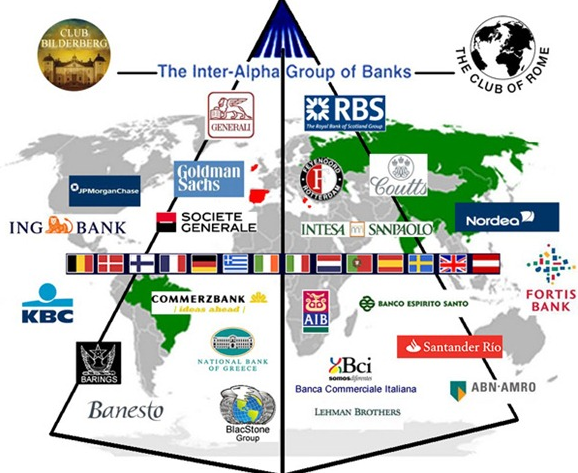The central banks of the world are some of the most powerful and influential financial institutions in the world. They are responsible for setting monetary policy, issuing currency, and managing a country’s foreign exchange reserves. Central banks are typically owned by governments and are usually independent from them, meaning that they are not subject to political interference. While central banks have considerable influence over the economic policies of governments, they do not control them. Rather, central banks are designed to act as a check on governments, helping to ensure that their policies are sound and beneficial for the economy.
The owners of central banks worldwide are primarily governments, though some central banks are owned by private shareholders. In most countries, central banks are independent from the government and their primary focus is on regulating the financial system, setting monetary policy, and managing the nation’s currency. In some cases, central banks may influence government policies, but they do not control them directly. Ultimately, the success of a central bank depends on its ability to foster economic stability and promote financial prosperity.

Analyzing How Central Bank Ownership Can Affect a Country’s Fiscal Policy and Political Stability
The ownership structure of a central bank has a significant effect on a country’s fiscal policy and political stability. Central banks are responsible for managing a country’s money supply, setting interest rates, and other aspects of economic policy. Depending on who owns the central bank, these policies can vary drastically, resulting in different economic outcomes. If a central bank is owned by a government or public entity, it is generally considered to be more independent from political influence. This allows central banks to make decisions that are in the best interest of the country’s economy, regardless of political pressure. Government-owned central banks typically have the freedom to make decisions without fear of repercussions from politicians. This can lead to more consistent and sound economic policy, as well as greater political stability. On the other hand, if a central bank is owned by private individuals or entities, it may be more susceptible to political influence. Private ownership often means that the bank’s decisions are subject to the whims of its owners, who may have their own agendas. This can result in central banks making decisions that are not in the best interests of the country, or that are designed to benefit certain people or groups. This can lead to economic policies that are not sound, as well as increased political instability. Overall, the ownership structure of a central bank can have a significant effect on a country’s fiscal policy and political stability. Government ownership typically leads to greater economic stability and independence from political influence, while private ownership can lead to more instability and greater susceptibility to political pressure. It is important to consider this when deciding who should own a country’s central bank.
Exploring the Role of Central Bank Owners and Their Influence on Governments
Central banks are the most important financial institutions in any economy, as they are responsible for managing the monetary policy of a nation. The ownership of central banks varies from country to country, and it is important to understand the role of central bank owners and how they influence governments. In some countries, such as the United States, the central bank is owned by the government. In this case, the government is responsible for setting the monetary policy and for appointing the board of governors. These governors are responsible for implementing the decisions of the government. This type of ownership allows the government to have a direct influence on the policies of the central bank. In other countries, such as the United Kingdom, the central bank is owned by private entities. These entities have the same authority as the government in setting the monetary policy and appointing the board of governors. However, the private owners have a more direct influence on the decisions of the central bank, as they are the ones who actually own the institution. In this case, the government must take into consideration the opinions of the private owners when making decisions. Finally, some countries, such as Japan, have a hybrid model of ownership. This means that the government and private entities both have a stake in the ownership of the central bank. In this case, the government is still responsible for setting the overall framework and appointing the board of governors, but the private owners are also consulted when making decisions. Overall, it is important to understand the role of central bank owners and their influence on governments. Depending on the ownership structure, the government may have a greater or lesser degree of influence on the policies of the central bank. In addition, private owners may have a more direct influence on the decisions of the central bank, depending on the structure of ownership. Understanding the role of ownership can help to improve the effectiveness of monetary policy and ensure that it is in line with the interests of the people.
Unpacking the Global Network of Central Bank Owners and Their Economic Impact
The global economy is a highly interconnected system with a complex network of central banks playing a critical role in its operation. Central banks, which are typically owned by governments or private entities, provide a range of services and functions, from maintaining the stability of currencies to setting interest rates. They also play an important role in regulating global financial markets and providing financial services to citizens, businesses, and governments. As such, understanding the ownership structure of central banks and their economic impact is essential for anyone interested in the global economy. Central banks are typically owned by either governments or private entities. Government-owned central banks are typically established by national governments and are fully funded by public funds. Private central banks, on the other hand, are typically owned by private entities, such as financial institutions and wealthy individuals. In some cases, central banks may be partially owned by both governments and private entities. The economic impact of central banks is far-reaching. Central banks play a key role in setting and implementing monetary policies, such as setting interest rates and influencing the exchange rate of currencies. These policies can have a significant impact on the global economy, as they can influence the cost of borrowing, the flow of capital, and the availability of credit in different countries. Central banks also provide financial services to citizens, businesses, and governments, such as issuing currency and providing loans. In addition to their economic impact, central banks also play an important role in ensuring the stability of financial markets. Central banks are responsible for maintaining the stability of currencies by monitoring the financial system and intervening when necessary to prevent market disruptions. They also provide liquidity to the markets, helping to ensure that banks and other financial institutions have enough capital to meet the demands of their customers. The global network of central banks and their economic impact are complex and interconnected. As such, it is important to understand the ownership structure of these banks and the economic impact they have on the global economy. By doing so, we can gain a better understanding of the global financial system and the role that central banks play in it.
Examining the Power of Central Bank Ownership to Control Economic Policy
Central banks are powerful institutions that influence the financial and economic policy of a nation. They are responsible for controlling the money supply, setting interest rates, and managing exchange rates. They are also responsible for establishing monetary policy and setting regulatory standards. As such, they have a significant impact on a nation’s economic outlook. The power of a central bank is largely determined by its ownership. Many central banks are owned and operated by the government, while others are partially or fully owned by private entities. Government-owned central banks enjoy greater authority than those owned by the private sector. This is due to the fact that government ownership gives them more power to implement economic policies that are in line with the government’s objectives. Private ownership of central banks is often seen as a way to ensure that monetary policy is independent from political interference. This is because private owners are motivated by profit, rather than political gain. However, this form of ownership comes with its own set of challenges. Private owners may have different objectives than the government and may be more focused on short-term gains than long-term economic stability. It is important for governments to assess the ownership structure of their central banks before implementing economic policies. Government-owned central banks are typically more powerful and have more autonomy in their decision-making than those owned by the private sector. This allows them to make more informed decisions and better control the direction of the economy. On the other hand, private ownership can limit the power of the central bank to implement economic policies and may lead to instability. In conclusion, the ownership structure of a central bank is an important factor to consider when examining its ability to control economic policy. Government-owned central banks are typically more powerful than those owned by the private sector, and may be better equipped to implement economic policies in line with the government’s objectives. However, private ownership of central banks can also lead to instability and should be carefully evaluated.
Investigating Who Owns Central Banks Worldwide and What It Means for Governments
Central banks are important public institutions that are responsible for controlling the monetary policy of a country. They are typically owned by the government and their purpose is to promote economic stability and growth. However, in some cases, central banks are not directly owned by the government, but rather by private individuals or entities. This raises important questions about who owns central banks worldwide and what it means for governments. In some countries, central banks are publicly owned and operated by the government. This is the case in the United States, where the Federal Reserve System is owned by the U.S. Treasury. In this situation, the government has ultimate control over the bank’s policies and is responsible for any losses or profits the bank may incur. However, in some countries, central banks are privately owned and operated. This is the case in countries like the United Kingdom, where the Bank of England is owned by a consortium of private banks. In this situation, the government still has some control over the bank’s policies, but the ultimate control lies with the private owners. This means that the profits and losses of the bank are not necessarily shared with the government and may instead go to private individuals or entities. The ownership of central banks can have serious implications for governments. If a central bank is privately owned, it can be used to influence government policies, as the private owners may have a vested interest in certain policies. Furthermore, if a central bank is not publicly owned, it can be more difficult for the government to ensure that the bank is acting in the best interests of the public. Overall, it is important to understand who owns central banks worldwide and what it means for governments. In many cases, central banks are publicly owned and operated, meaning that the government has ultimate control over their policies. In other cases, however, central banks are privately owned and operated, meaning that their profits and losses are not necessarily shared with the government. It is important for governments to be aware of this, as the ownership of central banks can have serious implications for their policies.






